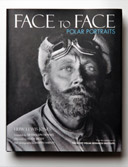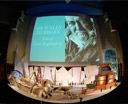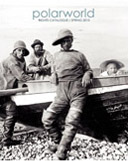 Our ProductsOur Resources |
This website requires the free Flash plugin to be installed.
Polarworld - discover more polar booksThe Arctic Book Review Ancient Mariner: The Amazing Adventures of Samuel Hearne, Ancient Mariner: The Amazing Adventures of Samuel Hearne, The Sailor Who Walked to the Arctic Ocean Ken McGoogan Ken McGoogan has been rightly praised for his previous book Fatal Passage, a long-overdue rehabilitation of the wrongly-tarnished reputation of Dr. John Rae, the man who indeed (as the title claims) "discovered the fate of Franklin." McGoogan now returns with another (equally lengthy) title, which claims Samuel Hearne alternately as "The Sailor Who Walked to the Arctic Ocean" (Canadian) or "The Man Who Inspired Coleridge's Masterpiece" (US). Yet in this book, McGoogan is not trying to restore our admiration for a neglected explorer, but to revive interest in an already-familiar one, a quite different kind of project. McGoogan does everything he can to stir up our interest and sympathy with Hearne, but in the end he remains a far less fascinating character than Rae. The fault here is not so much with Hearne who, from the narratives and materials he left behind, is certainly a captivating figure, but with McGoogan, who simply cannot resist the urge to pepper his book with fictive reconstructions of bygone moments. McGoogan's method is consistent – but whereas, as Roland Huntford observed in the New York Times, McGoogan in his previous book "may be forgiven a purple passage or two" for bringing Rae "out of the shadows," there's much less room for forgiveness here. McGoogan consistently, from beginning to end, invents and dramatizes scenes for which there is simply no historical evidence whatsoever. When Hearne's mother signs him up with Captain Samuel Hood, we're brought into the room and treated to a long, detailed, and utterly fictitious scene in which that much-honored commander is forced to utter banalities along the lines of "it's not an easy life, the Royal Navy," and "I have drawn up the requisite papers." Scenes like this, repeated throughout the book, undercut McGoogan's credibility, and worse – they obscure the intrinsic drama of events which, had they been allowed to speak for themselves, would have been far more powerful and affecting. It's not that he hasn't done his historical research – indeed, McGoogan supplies a never-ending stream of historical background which sets the scene admirably – but, rather like a badly-written period film made using historically-accurate costumes and brilliant art direction, the fine trimmings aren't enough to distract us from the failure of the central narrative. Yet despite these problems, here and there, the events of Hearne's life are sufficiently powerful in and of themselves that they redeem for a time the reader's mortgaged credulity, and McGoogan wisely wheels away his portable puppet-show. This is certainly the case with what is, of necessity, the book's most dramatic moment, the brutal massacre of an entire band of Inuit by Hearne''s Indian guides at a place ever after known as Bloody Fall (later Bloody Falls). McGoogan wisely chooses to quote Hearne's own narrative at length. Hearne's account, with its unflinching description of the murder and mutilation of a people, the young and the old alike, is tremendously affecting, its power undiminished by the intervening centuries. McGoogan fills in some of the surrounding events, and offers both a painting by George Back and a contemporary photograph by (ABR contributor) Paul vanPeenen as visual aids, but otherwise wisely remains in the background. Then, just after the destruction of the last surviving group of tents, McGoogan notes that Hearne, "having travelled two days without sustenance," joined his murderous guides at their campfire for a meal of salmon: "A sated Matonabbee, still licking his fingers, said, 'Now we will finish your survey.'" This is the precisely kind of moment one wishes there were more of in this book. It requires a judicious admixture of what is known and what is imagined to write a successful biography, and here the scales are simply tipped too much in favor of the imagination – McGoogan's, rather than the reader's. In addition, there is the element of uncertainty or ambiguity, a feature of any but the most well-documented life, which simply cannot survive McGoogan's impulse to fill in all the blanks. This is nowhere more evident than in McGoogan's efforts to anoint Hearne as "the" inspiration for Samuel Taylor Coleridge's "Ryme of the Ancient Mariner," a claim which, by the look of the title, is seen as especially important to the forthcoming U.S. edition. Coleridge, indeed, was acquainted with Hearne's narrative, and in all likelihood was influenced by it – and yet this is no reason to set aside all other claimants, or reduce the tremendous range of Coleridge's fancy to the wrong-ended telescope of one man. McGoogan, as ever, has done a good deal of commendable research, but his desire to boil everything down to Hearne, combined with the above proclivity for fictionalizing the trains of thought of others, is the very reductio ad absurdum of his method. What matter, one cannot resist asking, whether Hearne was the sole inspiration or one of many for Coleridge's masterpiece? Would it be lessened in our estimation as a result? Another of the pantheon of Romantic poets, John Keats, wrote of something he called "negative capability" – in short, the capacity to hold in one's mind, in complementary abeyance, two utterly opposed ideas. This ability is one which McGoogan sorely lacks, and a sign of this is his pushing all the controversial matter of the book to the end, where he "deals" with such quibblers as would cloud his crystalline picture of Hearne. Thus it is not until page 287 that we have the admission that, according to at least some First Nations eyewitnesses, Hearne was not – despite the power of his prose – present at the massacre at Bloody Fall. McGoogan, to his credit, gives some credence to this possibility, but then promptly boils away the whole kettle into steam. Certainly, our view of Hearne's account would be powerfully altered were it to be proven an imaginative reconstruction, as the native evidence clearly suggests – and yet McGoogan's sympathies inexplicably remain with Hearne. A better historian would make such conflicting testimonies the center, rather than the periphery, of his study. Those who – rightly – find Hearne's life to be a fascinating one, should read his own narrative, the most substantial (and almost the only) text he has left us, and one which fortuitously has been available online for some time. For those who are unfamiliar with this story, McGoogan's book provides at best a palatable placebo in place of the richly enigmatic and fragmentary histories it endeavors to overwrite. |
|
||
follow us  | join us | join us  | home | contact | home | contact
|
||||
|
© Copyright Polarworld Ltd
SiteWizard.co.uk Web Site Design Company |
||||


